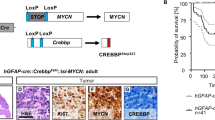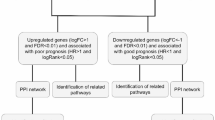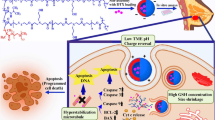Summary
A double staining technique was developed for the simultaneous measurement of tissue hypoxia and the concentration of non-protein sulphydryls (NPSH), based on the fluorinated nitroimidazole EF5 and the fluorescent histochemical NPSH stain 1-(4-chloromercuriphenoylazo)-naphthol-2 (mercury orange). Cryostat sections of tumour tissue were examined by fluorescence image analysis, using a computer-controlled microscope stage to generate large tiled field images of the cut tumour surface. This method was applied to the human cervical squamous cell carcinoma lines ME180 and SiHa, grown as xenografts in severe combined immunodeficient (SCID) mice, in order to determine if there is a systematic relationship between tissue hypoxia and NPSH levels. Hypoxic regions of the tumours, defined by EF5 labelling, were found to show greater NPSH concentrations relative to better oxygenated regions. This is probably due to increases in glutathione, since the ME180 and SiHa xenografts contained low levels of cysteine and metallothionein; the other major cellular thiols that can bind to mercury orange. Because the effects of glutathione on radiation and chemotherapy resistance are likely to be greater under hypoxic conditions, these results have potentially important implications for the study of resistance mechanisms in solid tumours.
Similar content being viewed by others

Article PDF
Change history
16 November 2011
This paper was modified 12 months after initial publication to switch to Creative Commons licence terms, as noted at publication
References
Asghar, K, Reddy, BG & Krishna, G (1975). Histochemical localization of glutathione in tissues. J Histochem Cytometry 23: 774–779.
Biaglow, JE, Varnes, ME, Epp, ER, Clark, EP, Tuttle, SW & Held, KD (1989). Role of glutathione in the aerobic radiation response. Int J Radiation Oncol Biol Phys 16: 1311–1314.
Brizel, DM, Scully, SP & Harrelson, JM et al (1996). Tumor oxygenation predicts for the likelihood of distant metastases in human soft tissue sarcoma. Cancer Res 56: 941–943.
Brizel, DM, Sibley, GS, Prosnitz, LR, Scher, RL & Dewhirst, MW (1997). Tumor hypoxia adversely affects the prognosis of carcinoma of the head and neck. Int J Radiat Oncol Biol Physics 38: 285–289.
Bump, EA & Brown, JM (1990). Role of glutathione in the radiation response of mammalian cells in vitro and in vivo. Pharmac Ther 47: 117–136.
Bump, EA, Cerce, BA, Al-Sarraf, R, Pierce, SM & Koch, CJ (1992). Radioprotection of DNA in isolated nuclei by naturally occurring thiols at intermediate oxygen tension. Radiat Res 132: 94–104.
Coleman, CN, Bump, EA & Kramer, RA (1988). Chemical modifiers of cancer treatment. J Clin Oncol 6: 709–733.
Fyles, AW, Milosevic, M & Wong, R et al (1998). Oxygenation predicts radiation response and survival in patients with cervix cancer. Radiother Oncol 48: 149–156.
Hockel, M, Schlenger, K, Aral, B, Mitze, M, Schaffer, U & Vaupel, P (1996). Association between tumor hypoxia and malignant progression in advanced cancer of the uterine cervix. Cancer Res 56: 4509–4515.
Koch, CJ & Evans, SM (1996). Cysteine concentrations in rodent tumors: unexpectedly high values may cause therapy resistance. Int J Cancer 67: 661–667.
Larrauri, A, Lopez, P, Lechon-Gomez, MJ & Castell, JV (1987). A cytochemical stain for glutathione in rat hepatocytes cultured on plastic. J Histochem Cytochem 35: 271–274.
Lord, EM, Harwell, L & Koch, CJ (1993). Detection of hypoxic cells by monoclonal antibody recognizing 2-nitroimidazole adducts. Cancer Res 53: 5721–5726.
Meister, A (1991). Glutathione deficiency produced by inhibition of its synthesis, and its reversal: applications in research and therapy. Pharmac Ther 51: 155–194.
Mitchell, JB & Russo, A (1987). The role of glutathione in radiation and drug induced cytotoxicity. Br J Cancer 55: 96–104.
O’Dwyer, PJ, Yao, K-S, Ford, P, Godwin, AK & Clayton, M (1994). Effects of hypoxia on detoxicating enzyme activity and expression in HT29 colon adenocarcinoma cells. Cancer Res 54: 3082–3087.
Orta, T, Eady, JJ, Peacock, JH & Stell, GG (1995). Glutathione manipulation and the radiosensitivity of human tumour and fibroblast cell lines. Int J Radiat Biol 68: 413–419.
Philbert, MA, Beiswanger, CM, Waters, DK, Reuhl, KR & Lowndes, HE (1991). Cellular and regional distribution of reduced glutathione in the nervous system of the rat: histochemical localization by mercury orange and o-phthaldialdehyde-induced histofluorescence. Toxicol Appl Pharmacol 107: 215–227.
Prise, KM, Gillies, NE & Michael, BD (1998). Evidence for a hypoxic fixation reaction leading to the induction of ssb and dsb in irradiated DNA. Int J Radiat Biol 74: 53–59.
Romero, FJ, Zukowski, D & Mueller-Klieser, W (1997). Glutathione content of V79 cells in two- or three-dimensional culture. Am J Physiol 272: C1507–C1512.
Slater, AFG, Stefan, C, Nobel, I, van den Dobbelsteen, DJ & Orrenius, S (1996). Intracellular redox changes during apoptosis. Cell Death Differ 3: 57–62.
Solen, G, Edgren, M, Scott, OC & Revesz, L (1989). Cellular glutathione content and K values. Int J Radiat Biol 55: 201–210.
Tew, KD (1994). Glutathione-associated enzymes in anticancer drug resistance. Cancer Res 54: 4313–4320.
Thomas, M, Nicklee, T & Hedley, DW (1995). Differential effects of depleting agents on cytoplasmic and nuclear non-protein sulphydryls: a fluorescence image cytometry study. Br J Cancer 72: 45–50.
Author information
Authors and Affiliations
Rights and permissions
From twelve months after its original publication, this work is licensed under the Creative Commons Attribution-NonCommercial-Share Alike 3.0 Unported License. To view a copy of this license, visit http://creativecommons.org/licenses/by-nc-sa/3.0/
About this article
Cite this article
Moreno-Merlo, F., Nicklee, T. & Hedley, D. Association between tissue hypoxia and elevated non-protein sulphydryl concentrations in human cervical carcinoma xenografts. Br J Cancer 81, 989–993 (1999). https://doi.org/10.1038/sj.bjc.6690797
Received:
Revised:
Accepted:
Published:
Issue date:
DOI: https://doi.org/10.1038/sj.bjc.6690797


